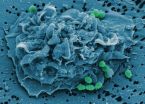(Press-News.org) Berkeley — Prenatal and childhood exposure to flame retardant compounds are linked to poorer attention, fine motor coordination and IQ in school-aged children, a finding by researchers at the University of California, Berkeley, that adds to growing health concerns over a chemical prevalent in U.S. households.
The new study, to be published in the Nov. 15 issue of the journal Environmental Health Perspectives, focuses on PBDEs, or polybrominated diphenyl ethers, a class of persistent, endocrine-disrupting compounds widely found in foam furniture, electronics, carpets, upholstery and other consumer products. The chemicals easily leach out into the environment and are inhaled or ingested through dust, then accumulate in human fat cells.
The researchers collected blood samples taken from 279 women during pregnancy or at delivery, and from 272 of the children when they were 7 years old. Analyses of the blood samples were conducted at the U.S. Centers for Disease Control and Prevention (CDC) in Atlanta.
The children participated in a battery of standardized tests when they were 5 and 7 to assess their attention, fine motor coordination and IQ (verbal comprehension, perceptual reasoning, working memory, processing speed). Mothers and teachers also completed assessment questionnaires to help evaluate the children's attention skills and behavior.
"This is the largest and most comprehensive study to date to examine neurobehavioral development in relation to body burden measures of PBDE flame retardants," said study lead author Brenda Eskenazi, Jennifer and Brian Maxwell Professor of Maternal and Child Health and Epidemiology. "We measured PBDEs both in the mothers during pregnancy and in the children themselves. It shows that there is a relationship of in utero and childhood levels to decrements in fine motor function, attention and IQ."
The new findings stem from a longitudinal study, the Center for the Health Assessment of Mothers and Children of Salinas (CHAMACOS), which examines environmental exposures and reproductive health. The study participants are primarily Mexican-Americans living in an agricultural community in Monterey County. Earlier studies found that children from the CHAMACOS group had PBDE blood concentrations seven times higher than children living in Mexico.
Evidence of adverse human health effects from PBDE exposure has been steadily building over the past decade. Other CHAMACOS studies have also revealed links between flame retardant concentrations in mothers' blood and decreased fertility, lower birthweight babies and changes in thyroid hormone levels, even after controlling for exposure to pesticides and other environmental chemicals. And findings from other smaller studies have linked deficits in physical and mental development in young children to prenatal exposure to PBDEs.
"This new study is very important because it confirms earlier published research on the neurodevelopmental effects of PBDE exposure," said Heather Stapleton, associate professor of environmental chemistry at Duke University and one of the nation's leading experts on human exposure to flame retardant chemicals. Stapleton was not part of the UC Berkeley study.
Use of PBDEs increased in the 1970s in response to a California standard (Technical Bulletin 117) requiring that consumer furnishings be able to withstand a small open flame for 12 seconds without igniting.
Today, PBDEs can be found in the blood of up to 97 percent of U.S. residents, with those in California having levels nearly twice the national average, according to studies.
"Within the range of PBDE exposure levels, 5 percent of the U.S. population has very high exposure levels, so the health impact on children in these extremes could be even more significant," noted Stapleton.
There are three formulations of PBDEs — pentaBDE, octaBDE and decaBDE — that have been developed for commercial use as flame retardants. Penta- and octaBDE have both been banned for use in several U.S. states, including California, but they are still present in products made before 2004. In addition, three major manufacturers have agreed to phase out production of decaBDE by 2013.
"Even though pentaPBDEs are not being used anymore, old couches with foam that is disintegrating will still release PBDEs," said Eskenazi, director of the Center for Environmental Research and Children's Health (CERCH) at UC Berkeley. "These chemicals will be in our homes for many years to come, so it's important to take steps to reduce exposure."
Examples of things that people can do at home include:
Seal any tears in couches and upholstered furniture
Damp mop and vacuum frequently
Wash hands frequently (especially important for children)
### CERCH has also posted information about PBDEs online (http://cerch.org/environmental-exposures/pbde-flame-retardants/).
Co-authors of the study are Jonathan Chevrier, Stephen Rauch, Katherine Kogut, Kim Harley, Caroline Johnson, Celina Trujillo and Asa Bradman at CERCH; and Andreas Sjodin at the CDC's Division of Laboratory Sciences.
The U.S. Environmental Protection Agency and the National Institute of Environmental Health Sciences provided major funding for this research.
Flame retardants linked to neurodevelopmental delays in children
2012-11-15
ELSE PRESS RELEASES FROM THIS DATE:
At least one-third of marine species remain undescribed
2012-11-15
At least one-third of the species that inhabit the world's oceans may remain completely unknown to science. That's despite the fact that more species have been described in the last decade than in any previous one, according to a report published online on November 15 in the Cell Press publication Current Biology that details the first comprehensive register of marine species of the world—a massive collaborative undertaking by hundreds of experts around the globe.
The researchers estimate that the ocean may be home to as many as one million species in all—likely not more. ...
Surprising genetic link between kidney defects and neurodevelopmental disorders in kids
2012-11-15
New York, NY (November 15, 2012) — About 10 percent of kids born with kidney defects have large alterations in their genomes known to be linked with neurodevelopmental delay and mental illness, a new study by Columbia University Medical Center (CUMC) researchers has shown.
The study was published today in the online edition of the American Journal of Human Genetics.
Congenital defects of the kidney and urinary tract account for nearly 25 percent of all birth defects in the US and are present in about 1 in every 200 births. Eventually, an evaluation for genomic alterations ...
Appetite suppressant for scavenger cells
2012-11-15
This press release is available in German.
When infected with influenza, the body becomes an easy target for bacteria. The flu virus alters the host's immune system and compromises its capacity to effectively fight off bacterial infections. Now, a team of immunologists at the Helmholtz Centre for Infection Research (HZI) and cooperation partners has discovered that an immune system molecule called TLR7 is partly to blame. The molecule recognizes the viral genome – and then signals scavenger cells of the immune system to ingest fewer bacteria. The researchers published ...
This is your brain on freestyle rap
2012-11-15
Researchers in the voice, speech, and language branch of the National Institute on Deafness and Other Communication Disorders (NIDCD) at the National Institutes of Health (NIH) have used functional magnetic resonance imaging to study the brain activity of rappers when they are "freestyling" – spontaneously improvising lyrics in real time. The findings, published online in the November 15 issue of the journal Scientific Reports, reveal that this form of vocal improvisation is associated with a unique functional reallocation of brain activity in the prefrontal cortex and ...
About one million species inhabit the ocean
2012-11-15
Every taxonomist has calculated the number of existing species within their specialty and estimated the number that remain to be discovered, both through statistical models as based on the experience of each expert. According to Enrique Macpherson, researcher at the Center for Advanced Studies of Blanes (CEAB-CSIC, Spain), who has participated in the study: "Bringing together the leading taxonomists around the world to pool their information has been the great merit of this research".
The statistical prediction is based on the rate of description for new species in recent ...
Penn study decodes molecular mechanisms underlying stem cell reprogramming
2012-11-15
PHILADELPHIA – Fifty years ago, British researcher John Gurdon demonstrated that genetic material from non-reproductive, or somatic, cells could be reprogrammed into an embryonic state when transferred into an egg. In 2006, Kyoto University researcher Shinya Yamanaka expanded on those findings by expressing four proteins in mouse somatic cells to rewind their genetic clocks, converting them into embryonic-like stem cells called induced pluripotent stem cells, or iPS cells.
In early October, Gurdon and Yamanaka were awarded the 2012 Nobel Prize in Physiology or Medicine ...
Early 50s may be key time to reach baby boomers with health messages
2012-11-15
COLUMBUS, Ohio -- For baby boomers, the peak interest in health issues comes at about age 51, with a second peak coming near age 65, according to a new study.
The results may help doctors and other professionals target this generation with health messages at a time when they are most receptive to hearing them, the researchers said.
The study, based on a survey of Americans age 45 to 65, showed that people in their late 40s had the lowest levels of interest in health issues. Interest rose quickly, however, and peaked in the early 50s, then dropped slightly and plateaued ...
Feinstein Institute researchers discover plant derivative
2012-11-15
MANHASSET, NY – Researchers at The Feinstein Institute for Medical Research have discovered that tanshinones, which come from the plant Danshen and are highly valued in Chinese traditional medicine, protect against the life-threatening condition sepsis. The findings are published in the December issue of Biochemical Pharmacology.
Inflammation is necessary for maintaining good health – without inflammation, wounds and infections would never heal. However, persistent and constant inflammation can damage tissue and organs, and lead to diseases such as sepsis. Sepsis affects ...
Researchers tap into CO2 storage potential of mine waste
2012-11-15
VANCOUVER, CANADA, NOVEMBER 15, 2012 -- It's time to economically value the greenhouse gas-trapping potential of mine waste and start making money from it, says mining engineer and geologist Michael Hitch of the University of British Columbia (UBC).
Hitch studies the value of mine waste rock for its CO2-sequestration potential, or "SP." He says mining companies across Canada will, in future, be able to offset CO2 emissions with so-named "SP rock," and within 25 years could even be selling emissions credits.
Digging, trucking and processing make mining an energy-intensive ...
Eating more fish could reduce postpartum depression
2012-11-15
Low levels of omega-3 may be behind postpartum depression, according to a review lead by Gabriel Shapiro of the University of Montreal and the Research Centre at the Sainte-Justine Mother and Child Hospital. Women are at the highest risk of depression during their childbearing years, and the birth of a child may trigger a depressive episode in vulnerable women. Postpartum depression is associated with diminished maternal health as well as developmental and health problems for her child. "The literature shows that there could be a link between pregnancy, omega-3 and the ...


